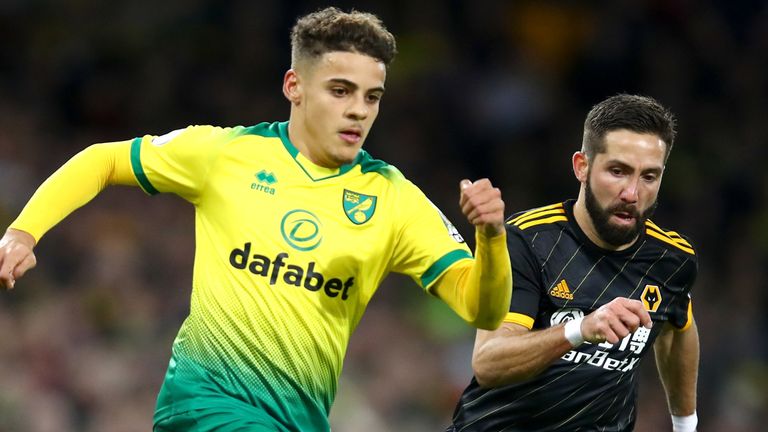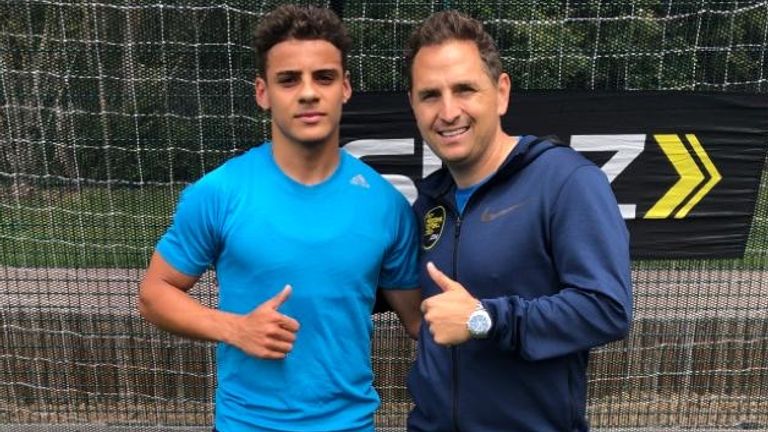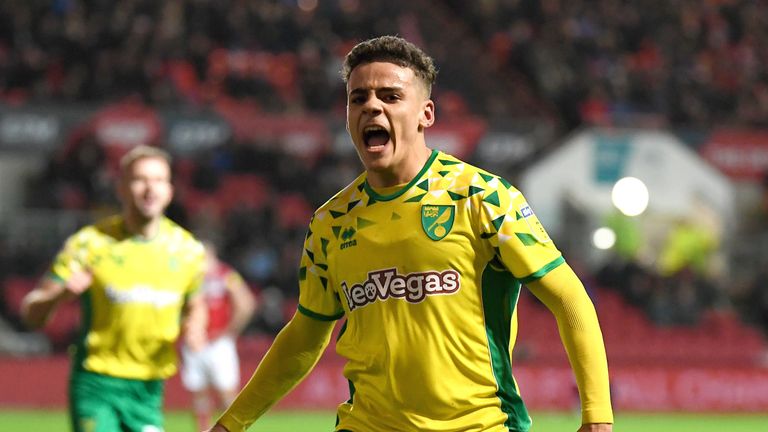Max Aarons: How Norwich's in-demand full-back went his own way
Max Aarons had big clubs ringing him "every day" in the summer and the January transfer window brings more interest, but his route into football was an unconventional one and this is still only the start

Thursday 9 January 2020 16:16, UK
Max Aarons was 14 years old when he took the bold decision to leave boyhood club Luton Town in search of bigger things. He did not have his next move lined up, but he had plenty of ambition and he had ability too.
It would eventually lead him to Norwich City, where he has since emerged as one of the most exciting young full-backs in the Premier League and a transfer target for Tottenham, Arsenal and Borussia Dortmund. What he didn't know at the time, however, was that he would spend the next two years in limbo.
- Dortmund interested in Aarons
- Spurs among clubs keen on Aarons
- Chasm between City and United
- Arteta getting his message across
During a pivotal period in a player's development, a period during which his contemporaries were honing their craft in professional academies, Aarons did not even have a club. He did have trials - some with sides now chasing his signature - but Tottenham said no and so too did Chelsea and QPR.
Instead, Aarons travelled from his family home in Milton Keynes to a Powerleague facility in north London several times per week for one-on-one, after-school training sessions with Saul Isaksson-Hurst, a personal coaching specialist known to his father, Mike, with a decade of experience as a youth coach at Tottenham and Chelsea.
"You wouldn't describe it as a normal pathway or even a recommended pathway for any player, but it worked for him," Isaksson-Hurst tells Sky Sports. "His dad tells me that when Max joined Norwich and he told people in the academy that he hadn't had a club for two years, they couldn't work it out or make sense of it."
It was certainly not for a lack of talent.
At Luton, a club with a proud history of producing professional players, his technical ability stood out from the start and his physical potential soon became evident too. He was seven when he joined them. At 11, Arsenal were keen to sign him but refused to pay a compensation fee which looks minuscule in comparison to the sums being touted for him now.
Later, during his trials at Tottenham and Chelsea, there were other factors at play too.
"He was just unfortunate, really," says Isaksson-Hurst. "They are two of the strongest academies in the country, so it is always going to be difficult to go in and be better than their best players. Max was still a forward player at the time, and they were well-stocked with attackers in his age group.
"But his resilience stood out. When he wasn't successful at Chelsea, for instance, he said he wanted to go back and prove them wrong. I told him maybe it wasn't right for him at the time, but he never had any self-doubt. He always believed he could play at that level. It was impressive to have that mind-set having been knocked back a few times."
That resilience was invaluable to Aarons during a period in which another player might have fallen out of the game altogether, but it was even more important that he still felt like he was progressing through his work with Isaksson-Hurst - despite not playing competitively outside his trial periods.
"It was very difficult and of course he was disillusioned at times, but he was passionate about our work and he got a lot out of it," says Isaksson-Hurst.
"We focused a lot on one-v-one domination, so we worked on all the key technical areas players need and did a lot of position-specific stuff, especially in wide areas. It was about how to beat a player, being as explosive and dynamic on the ball as possible, but also about how to produce end-product in terms of crosses, shots and passes."
It meant that, at 16, when he was offered a trial at Norwich by academy manager Gregg Broughton, who had previously held the same position at Luton, he was sharp enough to show his worth. Norwich had not been able to pay Luton the compensation needed to sign Aarons when Broughton joined them in 2014, but two years later an agreement was reached.
"When you step out of the game as Max did, it can be difficult to go back into it because you get comfortable in the environment you are in, but I had kept a dialogue going with his father and that helped us get him in at Norwich," Broughton, who is now academy director for Norwegian side Bodo-Glimt, tells Sky Sports.
"He came in and trained with us and travelled with us to Riga to play in an international tournament. Sometimes trialists come in and blow the world apart, but Max wasn't one of those. He had athletic potential - I'd seen that at Luton - but he was still physically very small at that stage because he hadn't gone through maturation."
Norwich knew it was only a matter of time before he filled out physically, but there was another hurdle to clear before they signed him.
"Max had been trialling as a midfielder everywhere else, but he could just run and run and run and he was good offensively, so we viewed him as a modern full-back," says Broughton. "I sat down with him and his father at the training ground during his trial. We looked at his video clips and I said, 'Max, if you're going to come into the club, it's going to be as a full-back.'"
Aarons was taken aback by the idea initially, but he was also open-minded. His appetite to learn and improve is another of his strengths.
"Even in those days, we were trying to play with very offensive full-backs at Norwich," says Broughton. "That was part of our philosophy and DNA, so for us it was just a case of explaining the role of a full-back in our system and letting him know that he was still going to get a lot of possession in offensive areas of the pitch. I think that helped."
Broughton credits Matt Gill, Norwich's former U16s coach and now Paul Lambert's assistant at Ipswich, as the key figure in Aarons' transition to full-back and it also helped to have former Reading defender Graeme Murty, a veteran of the position, working as the club's U18s coach.
With their help, Aarons was soon excelling in his new position at academy level. Then, a few weeks into the 2018/19 Championship season - Daniel Farke's second at the helm - he broke into the senior side, making his league debut in a fiercely-contested East Anglian derby against Ipswich.
He has not looked back.
Since that afternoon at Portman Road, Aarons has racked up more league minutes than any other outfield player at Norwich. His marauding runs up their right flank were a feature of last year's promotion-winning campaign, earning him a place in the Championship team of the year, and even in what has been a difficult start to the new season, he has handled the step up impressively.
"I think the biggest credit in this whole story has to go to Daniel Farke and to [Norwich sporting director] Stuart Webber," says Broughton. "Stuart for creating a pathway for him, and Daniel for being brave enough to put him in the team when it would have been easier to sign senior players. They have stuck to their philosophy and Max has benefitted."
Aarons is not the only young player to have benefitted, of course. Jamal Lewis, his fellow Luton academy graduate, has shone at left-back, while Todd Cantwell and Ben Godfrey have also become key players. None of them, though, have attracted quite as much interest as Aarons.
"A couple of the big clubs were really into him in the summer, ringing him every day," says Isaksson-Hurst, who still does sessions with Aarons during the off-season. "A lot of players would have been turned by the attraction of a big club and big money, but he's got a very good head on his shoulders.
"He knew that the most important thing was to play. He realised that a season playing as an established Premier League player would be priceless, and if he does go somewhere else, he would need to know that the plan was for him to be the main man in his position. The career of a footballer is so delicate. You've got to make the right decisions for your development."
Aarons, the boy who chose to go his own way, knows that better than most.










